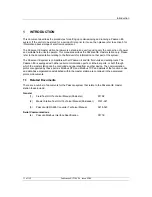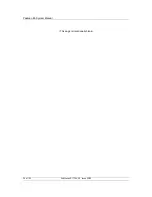
Pakscan IIE System Manual
20 of 132
Publication S177E V2.0 Issue 03/05
5.2.1 Loop
Configuration
The loop configuration phase is entered after power-up, after a loop fault is detected, or after a loop
configure command is received.
Configuration consists of the following steps:
1.
Wait for all the field units to go into loopback. The time is dependent on the baud rate.
2.
Issue a command from Port A to ask a field unit in loopback for its address. This finds the
first field unit.
3.
Use that address to tell the field unit to remove its loopback.
4.
Repeat steps 2 and 3 until no more field units are found.
5.
Attempt to send a message right round the loop and receive it back at the sending end.
This tests the integrity of the complete loop.
6.
If the loop is complete stop here. If the loop has a problem execute steps 7 to 10.
7.
Repeat steps 2 to 4 from Port B.
8.
Again wait for all field units to go into loopback.
9.
Remove loopbacks one field unit at a time from Port A until only the last field unit is left in
loopback.
10. Repeat step 9 for Port B.
Loop configuration will identify and mark as out of service any field unit found which has an address
that is zero, an address that is the same as one which has already been found, or which has an
address, which is too high. An address that is too high is one outside the range selected for the master
station.
The master station has the facility to double the loop Baud rate. If this facility is enabled, via the
Keypad, the master station will issue a broadcast command to all the field units to get them to double
the baud rate they are using, once it has detected that the loop is complete.
5.2.2
Normal Running Operation
In normal operation, the master station polls each field unit for any changed data it has to report. Most
of the time, field units have no changes to report, and traffic on the loop is kept to a minimum. Field
units are polled in address order. Data that might be reported includes changes to digital inputs, alarm
changes, or significant changes to an analogue input.
If a field unit, which previously responded on the last scan, fails to respond correctly the master station
will retry twice to get a reply. On subsequent scans only a single attempt is made to get a response.
All field units up to the address preset in the master station database are polled. Thus new field units
which are powered-up on a working loop will be identified by the master station, provided they are
within the selected address range, and future scans will poll the new field unit for data.
Commands to field units (open, close, etc.) are interleaved between polls to individual field units. This
ensures they are sent as soon as a slot is available. When the current transaction is completed the
command will be next.
A check is made at the end of each scan to see if a loop fault has occurred. For a complete loop with
no loopbacks present a test message is sent round the loop; for a broken loop (loopbacks in use)
















































